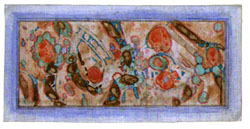
CHARLES SELIGER
Charles Seliger has a gift, and there is that wonderful way with the
"gifted" that we are blessed to share in it. I see these paintings
like so many different flowers that we might encounter, flowers whose perfume
remains a secret unless we pause to smell them. Much of the exciting painting
going on today gives us the sensuality and force of odors like gasoline,
wet asphalt, and mown grass; terrific smells, but they find their own way
to our noses. Seliger is more content to wait patiently until his flowers
catch our eye, and we have the leisure to lean over and fill our senses
with their delicate and refined fragrance.
Over the years artists, critics, and historians have repeatedly used words
like quiet, modest, small, and intimate to describe aspects of Seliger's
painting. These are accurate and telling adjectives which help to define
the conditions of this work; they are not, however, its virtues. Rather
they are the most objective way of locating the work-determining its place.
The value of this work in the most general sense is in the depth and intensity
of its experience as art; more specifically, in its power to do what nature
does, not with imitation, but through a parallel "synthetic" experience.
These paintings offer us what Seliger calls an "inner landscape."
These "inner landscapes" are complex abstract spaces hung on unconscious
beginnings. Seliger
accepts that premise, almost an arbitrary composition, painted "automatically,"
and lets it tell him the way. This "listening" in his work, which
is a holdover from Surrealism and the later Tachism, gives the paintings
their most compelling association with nature: they listen to us as well
as talk to us. In short, they offer us a relationship. They might gently
show us their way, as Seliger has evolved each image to allow ambiguity
and openness to foil his acute definition of form, but they also let us
go our own way. They let us be. In their intimacy they give us a world to
explore as they wish, bringing to them what we wish, and finally letting
us make them whatever we wish. They share their control, and Seliger is
a master at making that possible. These are carefully crafted images, but
they have nothing to prove. They are just an offer, some light, some wonder,
some beauty. If we have the time they lend us some touch, to be "in
touch." Like nature, they listen, and then quietly point out a way.
Over the years color has become more and more the partner to form in the
realization of these paintings; this marriage has steadily increased their
sensuality, extended their space, and given them a longer view. With the
range of color came more surface, more bonding by their relationships, and
more dimension as space, with more penetration and more relief. This all
meant less drawing and value structure, and greater aesthetic range and
possibility.
If we're lucky, between the extremes we find time to warm to the intimate.
Charles Seliger had fame early, as a very young person being counted among
the hot pistols of Abstract Expressionism in New York during the Forties
and Fifties. His abstractions were bold in their assertion of Surrealism
and Biomorphism, more about form than color, and brooding in their dramatic
impact. His work caught the imagination of the public, but as the light
passed into his work and he settled into his mature style, fame went its
way.
Now, in a fashion which poetically reflects both the artist and his work,
the Guggenheim is generously and quietly introducing twenty-four paintings
into their private collection. In this show we can see the greatest of Seliger's
achievements; not his peaks, or the feathers in his cap, but his real accomplishment-his
gift-his work: thirty-five years of wonder and light by a person who has
never stopped growing; a gentle voyage of discovery that carries all the
joy, pain, and learning in every passage. Their experience carries every
extreme with a remarkable consistency, and while the investigation and personality
of each may change, the vision is clearly the same.
Small is part of Seliger's method, and it is how he is known. Without overstating
this aspect of the work, it is fundamental to its intention. He wants us
to have to walk up close to enjoy it. He lures us in with a large set of
relationships in the picture that can't properly be seen from a distance.
Once he has us in close, we are in range for what he's really up to. If
we have the time, we take him up on it. It's not hard. The promise is fantastic.
That's the gift of it.
The work is greater now than ever. This particular body of work may be history,
but more than anything else it is a prelude. Seliger's gifts keep coming.
(Guggenheim Museum, March 14-May 18, 1985)
Addison Parks, Courtesy ARTS Magazine